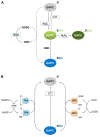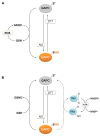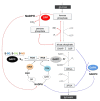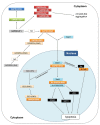Plant cytoplasmic GAPDH: redox post-translational modifications and moonlighting properties
- PMID: 24282406
- PMCID: PMC3824636
- DOI: 10.3389/fpls.2013.00450
Plant cytoplasmic GAPDH: redox post-translational modifications and moonlighting properties
Abstract
Glyceraldehyde-3-phosphate dehydrogenase (GAPDH) is a ubiquitous enzyme involved in glycolysis and shown, particularly in animal cells, to play additional roles in several unrelated non-metabolic processes such as control of gene expression and apoptosis. This functional versatility is regulated, in part at least, by redox post-translational modifications that alter GAPDH catalytic activity and influence the subcellular localization of the enzyme. In spite of the well established moonlighting (multifunctional) properties of animal GAPDH, little is known about non-metabolic roles of GAPDH in plants. Plant cells contain several GAPDH isoforms with different catalytic and regulatory properties, located both in the cytoplasm and in plastids, and participating in glycolysis and the Calvin-Benson cycle. A general feature of all GAPDH proteins is the presence of an acidic catalytic cysteine in the active site that is overly sensitive to oxidative modifications, including glutathionylation and S-nitrosylation. In Arabidopsis, oxidatively modified cytoplasmic GAPDH has been successfully used as a tool to investigate the role of reduced glutathione, thioredoxins and glutaredoxins in the control of different types of redox post-translational modifications. Oxidative modifications inhibit GAPDH activity, but might enable additional functions in plant cells. Mounting evidence support the concept that plant cytoplasmic GAPDH may fulfill alternative, non-metabolic functions that are triggered by redox post-translational modifications of the protein under stress conditions. The aim of this review is to detail the molecular mechanisms underlying the redox regulation of plant cytoplasmic GAPDH in the light of its crystal structure, and to provide a brief inventory of the well known redox-dependent multi-facetted properties of animal GAPDH, together with the emerging roles of oxidatively modified GAPDH in stress signaling pathways in plants.
Keywords: S-nitrosylation; cysteine thiols; glycolytic glyceraldehyde-3-phosphate dehydrogenase; moonlighting protein; redox modifications.
Figures









Similar articles
-
The Writers, Readers, and Erasers in Redox Regulation of GAPDH.Antioxidants (Basel). 2020 Dec 16;9(12):1288. doi: 10.3390/antiox9121288. Antioxidants (Basel). 2020. PMID: 33339386 Free PMC article. Review.
-
Mechanisms of nitrosylation and denitrosylation of cytoplasmic glyceraldehyde-3-phosphate dehydrogenase from Arabidopsis thaliana.J Biol Chem. 2013 Aug 2;288(31):22777-89. doi: 10.1074/jbc.M113.475467. Epub 2013 Jun 7. J Biol Chem. 2013. PMID: 23749990 Free PMC article.
-
Beyond glycolysis: multifunctional roles of glyceraldehyde-3-phosphate dehydrogenases in plants.Hortic Res. 2025 Mar 3;12(6):uhaf070. doi: 10.1093/hr/uhaf070. eCollection 2025 Jun. Hortic Res. 2025. PMID: 40303431 Free PMC article.
-
CP12-mediated protection of Calvin-Benson cycle enzymes from oxidative stress.Biochimie. 2014 Feb;97:228-37. doi: 10.1016/j.biochi.2013.10.018. Epub 2013 Nov 5. Biochimie. 2014. PMID: 24211189
-
Cytosolic thiol switches regulating basic cellular functions: GAPDH as an information hub?Biol Chem. 2015 May;396(5):523-37. doi: 10.1515/hsz-2014-0295. Biol Chem. 2015. PMID: 25581756 Review.
Cited by
-
Arabidopsis thaliana alcohol dehydrogenase is differently affected by several redox modifications.PLoS One. 2018 Sep 25;13(9):e0204530. doi: 10.1371/journal.pone.0204530. eCollection 2018. PLoS One. 2018. PMID: 30252897 Free PMC article.
-
Shared and genetically distinct Zea mays transcriptome responses to ongoing and past low temperature exposure.BMC Genomics. 2018 Oct 20;19(1):761. doi: 10.1186/s12864-018-5134-7. BMC Genomics. 2018. PMID: 30342485 Free PMC article.
-
The emerging pathogen Paecilomyces variotii - a novel and important fungal allergen source.Allergy. 2022 Mar;77(3):1045-1048. doi: 10.1111/all.15176. Epub 2021 Nov 23. Allergy. 2022. PMID: 34773271 Free PMC article. No abstract available.
-
Snakin-2 interacts with cytosolic glyceraldehyde-3-phosphate dehydrogenase 1 to inhibit sprout growth in potato tubers.Hortic Res. 2022 Jan 19;9:uhab060. doi: 10.1093/hr/uhab060. Online ahead of print. Hortic Res. 2022. PMID: 35043182 Free PMC article.
-
The Plastidial Glyceraldehyde-3-Phosphate Dehydrogenase Is Critical for Abiotic Stress Response in Wheat.Int J Mol Sci. 2019 Mar 4;20(5):1104. doi: 10.3390/ijms20051104. Int J Mol Sci. 2019. PMID: 30836662 Free PMC article.
References
-
- Anderson L. E., Bryant J. A., Carol A. A. (2004). Both chloroplastic and cytosolic phosphoglycerate kinase isozymes are present in the pea leaf nucleus. Protoplasma 223 103–110 - PubMed
-
- Bedhomme M., Adamo M., Marchand C. H., Couturier J., Rouhier N., Lemaire S. D., et al. (2012). Glutathionylation of cytosolic glyceraldehyde-3-phosphate dehydrogenase from the model plant Arabidopsis thaliana is reversed by both glutaredoxins and thioredoxins in vitro. Biochem. J. 445 337–347 10.1042/BJ20120505 - DOI - PubMed
Publication types
LinkOut - more resources
Full Text Sources
Other Literature Sources
Research Materials

